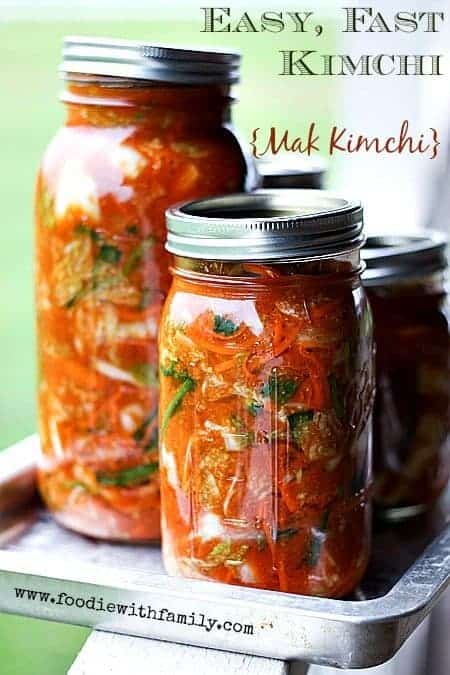
Love this Easy, Fast Mak Kimchi recipe? Check out our other fabulous Korean Food Recipes!
If you’ve been with me for a while, you’re well aware of my undying love for kimchi. Yes, it is stinky and bubbly and more than a little wild, but WOWZA the taste and the texture are so worth it.
If you’re new to the Foodie with Family family and you aren’t familiar with kimchi, I can give you a super condensed description; it’s essentially spicy, aromatic Korean sauerkraut. Today, I’m bringing you a fool-proof Easy Fast Kimchi recipe {Mak Kimchi}.
What is Kimchi?
Kimchi comes in almost as many forms as there are vegetables because nearly any vegetable can be fermented. They range from super mild smell to mega funky and mellow to melt-your-face-off spicy and there is one for every possible point in between.
The kimchi recipe that I’m sharing today is my family’s favourite version. It’s chock full of fabulous pro-biotics (as most kimchi is) and the longer it ages (translation: ferments) the stronger it becomes in both flavour AND pro-biotic content.
It’s like yogurt on steroids, people. That’s how good it is for you!
Is Kimchi Good For You?
Health Magazine named kimchi one of it’s Top 5 World’s Healthiest Foods. It is is low in calories and fat and high in dietary fiber and wicked high in Vitamins A, B, and C.
Many (if not most) Koreans eat a little kimchi with each meal or at least once a day. Kimchi is credited with helping most Koreans avoid obesity by virtue of its ability to satisfy even while being low calorie and low fat.
Seoul National University conducted a study and claimed that chickens infected with the H5N1 virus, also called avian flu, recovered after eating food containing the same cultured bacteria found in kimchi. That’s good enough for me!
How to Make Kimchi
Let’s get cracking and make some kimchi, shall we? The variety we’re making today is an Easy, Fast Kimchi recipe or Mak Kimchi…
In other words, it’s already cut up and ready to shovel into your mouth. Unlike what is usually just called ‘kimchi’ which is whole heads of napa cabbage smeared with the kimchi paste and allowed to ferment all wrapped up.
This version is FAR easier to make and far faster to be ready. Bonus, it is way easier to eat straight from the jar with a pair of chopsticks or a fork.
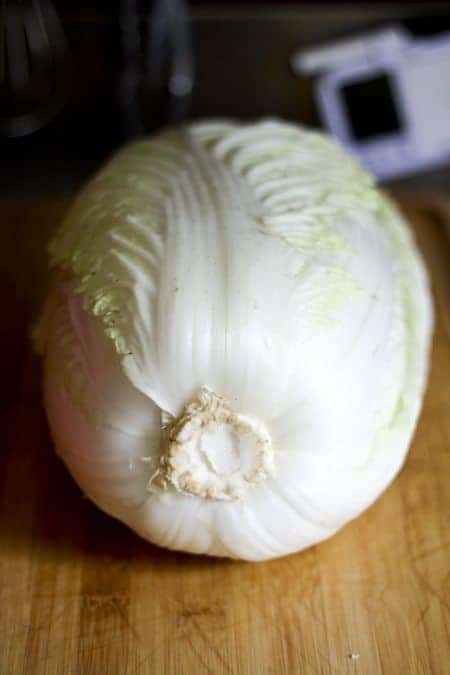
Do I need special tools to make kimchi?
In short, no. All you really need is a knife, a cutting board, and a big bowl. You will need a couple of ingredients that you may not have purchased before, but never fear, they’re not hard to find these days and I’ve included links to them below.
To begin with, you’ll need a big old head or two of Napa cabbage. I had two heads like the one above weighing in at about 3 pounds each.
It yielded, when all was said and done, about 3 quarts of kimchi, so that was perfect for me. You can cut that back if you think you can’t consume that amount of our Easy, Fast Kimchi recipe or Mak kimchi.
But I find all sorts of places to tuck it in, so it’s not an issue here and it’s only my husband, myself, and two of our boys who eat it. We love our kimchi.
Kimchi Recipe
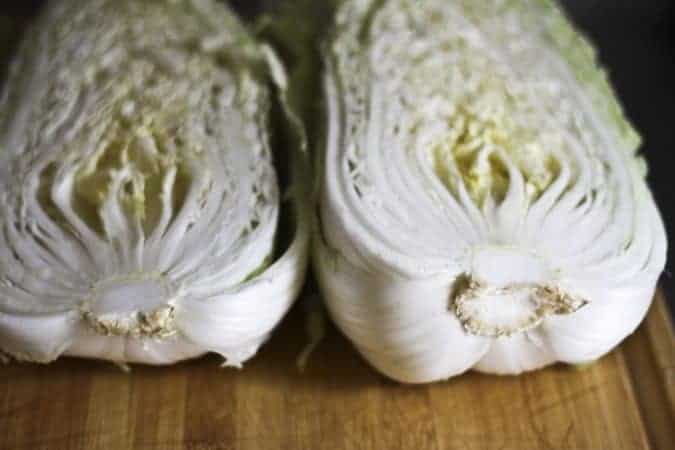
Lob your cabbages in half lengthwise. Use a paring knife to remove the gnarly core from them before cutting in half lengthwise again, leaving you with quarters.
Cut across the quarters to make bite-sized squares of cabbage. I usually shoot for 2-inch squares.
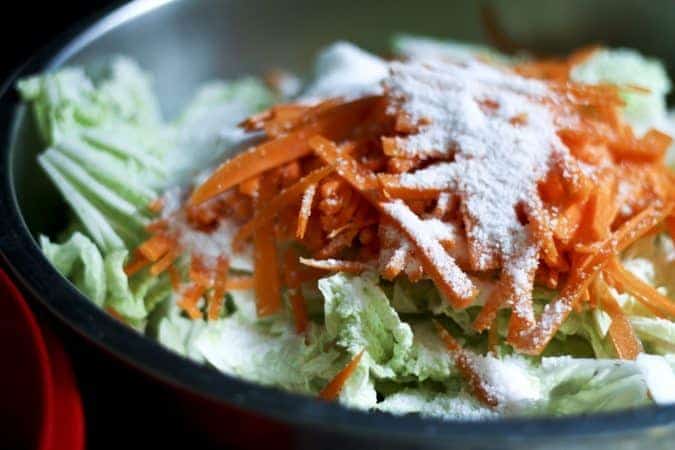
Add the cabbage to a monstrously huge bowl (or bowls), top with the julienned carrots, and sprinkle salt over the whole works. Toss the veggies and massage the mixture until the cabbage just starts to wilt.
Pour in enough cold water to over all the cabbage and carrots by a bit. It doesn’t have to be swimming in water, just covered.
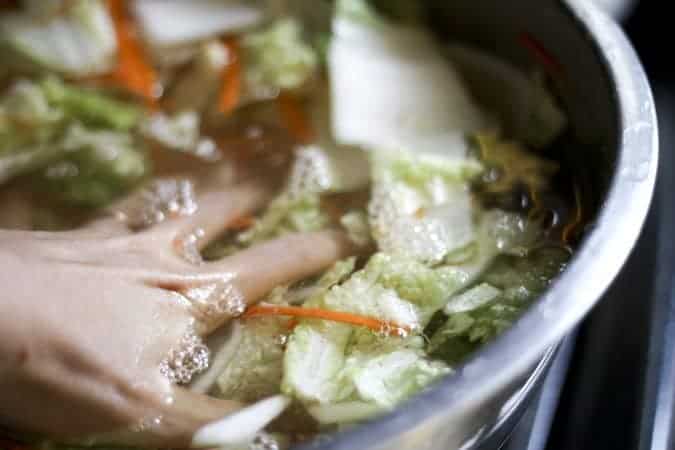
Stir it up with your hands and let it rest at room temp for a couple of hours.
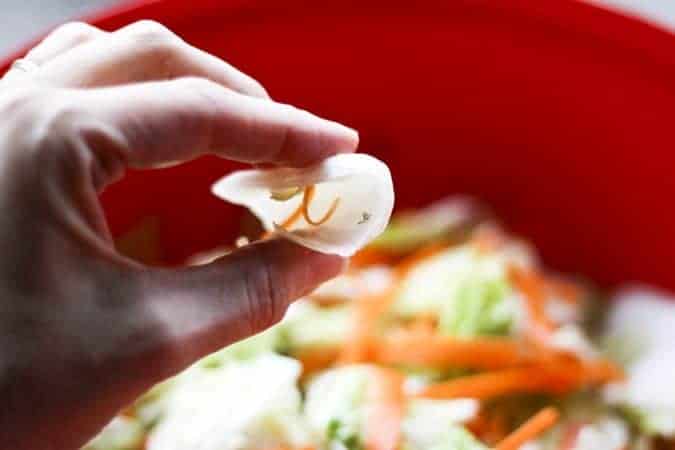
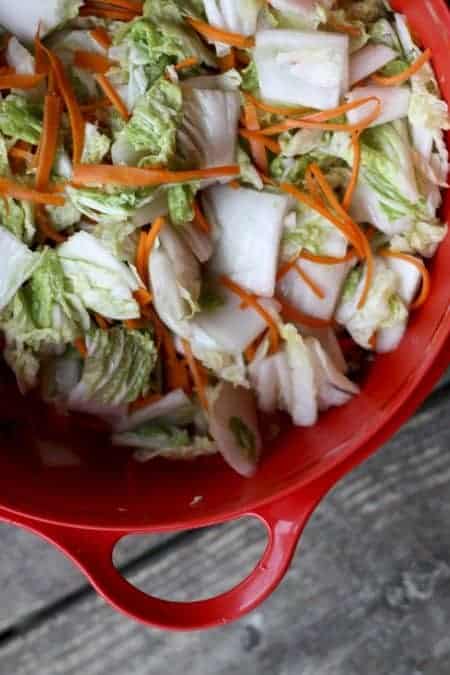
After a couple of hours, when the sturdier pieces of cabbage have become flexible, pour the whole lot into a strainer and let the brine water drain away.
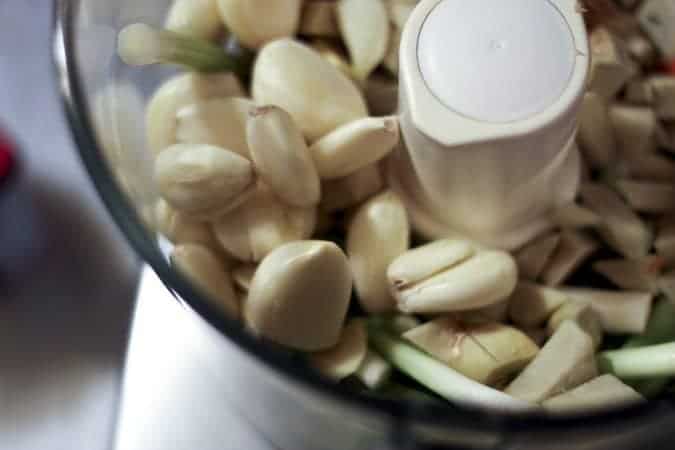
Now you’re going to whizz up the good stuff. Garlic, ginger, the white parts of scallions, Korean Red Pepper Powder*, fish sauce, unsweetened pear or apple juice, miso paste, and whatnot go into the food processor or blender.
Obliterate and smash it all into a lovely, red, fabulous smelling paste. It’s worth noting that you shouldn’t just up and increase the garlic because it can make kimchi linger more on your breath than you’d like it to do.
It also tastes out of balance if you add a lot more. Be aware.
And by the same token, you shouldn’t increase the ginger willy-nilly because that can make the final product a little more bitter than you’d like it to be. Start with the mixture and proportions I’m giving you and then play with it in subsequent batches.
*It’s important to note that you cannot use American or Mexican Chili Powder in place of the Korean pepper powder here. They’re COMPLETELY different animals. It may end up tasty, but I haven’t tested it so I cannot speak to it.
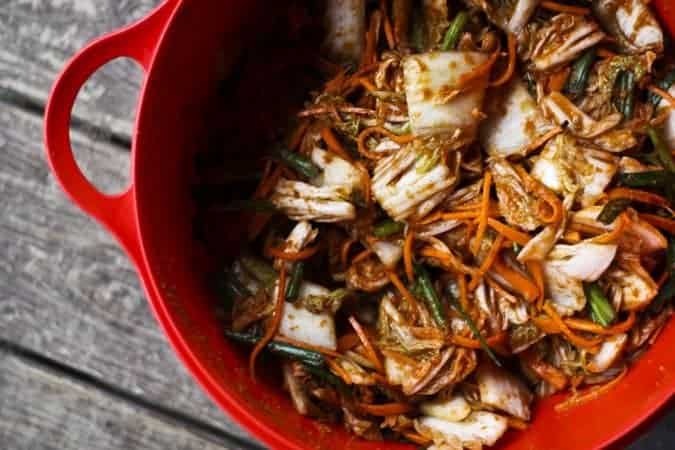
Now you’ll CRAM this stuff into jars or food-safe plastic containers. When I say cram it, I mean shove it in there as firmly as you can without putting your fist through the bottom of the jar.
I do prefer glass canning jars, if you’re wondering, because they don’t retain odors like plastic does, and, well, this stuff is odiferous! You can use a dedicated plastic kimchi bucket if you’d prefer, though.
Gently place a lid and ring on the jar, but don’t screw it tightly into place because BOOM. It’ll pop. This is active stuff, mes amies!
Place the jar on a rimmed pan or baking dish. The rim is pretty crucial here, because as the kimchi ferments at room temperature (and more slowly but still actively in the refrigerator) it will bubble up and may release a little juice over the edge of the jars.
In other words, you could have a kimchi river a-flowin’ on your counter top unless you take precautions. It’s easiest to use the pan and not worry about your Easy, Fast Kimchi recipe or Mak Kimchi bubbling over onto your counters.
It’s going to spend a couple of days at room temperature getting bubbly and fragrant. Every day, you’ll insert a clean chopstick or butter knife into the jar to help release air bubbles and top the jar off with extra brine if needed to keep everything submerged.
When it’s almost carbonated looking (usually between 24-72 hours after packing the jars), it’s ready to refrigerate. I highly recommend refrigerating it on the tray you used to contain the Grand Kimchi River while it fermented.
There aren’t a lot of things quite as unnecessary as removing everything from a fridge and mopping kimchi juices off of it. Take my word for it.
How long can I keep homemade kimchi?
It’s ready to eat at that point! Of course, it gets stronger and more kimchi-y the longer it sits. I love cooking with the older stuff and eating the newer stuff ‘raw’.
One of my all-time best-loved ways to eat older kimchi is in pancake form. Not like Aunt Jemima pancakes or flapjacks, but savoury, crispy-edged, kimchi-studded, pan-fried, snack cakes that convert even die-hard kimchi skeptics.
It’s the only way my eldest likes kimchi, but OH how he loves it this way. And the smell of kimchi pancakes while they cook is irresistible.
Bonus: This stuff lasts just about forever when you make sure the veggies are submerged in the brine. It’s hard to go wrong.
What can I make with my kimchi recipe? How do I use kimchi?
-Kimchi Fried Rice AND another version of Kimchi Fried Rice (the second one has a fried egg on top. SWOON!)
-Korean Army Stew- Budae Jjigae
-Kimchijeon (Savoury Kimchi Pancake)
Kimchi Ingredients
Kimchi
Cut the napa cabbage in half longways, then in half again longways. Cut the core out of the four quarters.
Cut the cabbage into squares (about 2-3 inches square), pop it in a bowl with the carrots. Sprinkle with the 1/2 cup kosher salt, massage so everything is coated in salt and starting to soften and wilt. Fill with cold, chlorine free water to cover it well and let it soak for at least 1 1/2 hours.
Pour the cabbage and carrots and liquid into a strainer. Let the brine drain away.
Lob off the white bits of the green onions and put them in a food processor with the garlic cloves, ginger, miso paste, and korean pepper powder. Zap it on high ’til it’s smooth-ish. Add in the fish sauce and a couple of slops of pear juice and zap it more until it’s about pancake batter consistency… maybe a bit thinner.
Put the brined cabbabe/carrots in a big, anti-reactive (glass, enamel, or stainless steel) bowl. Rough chop the green parts of the onions and add those to the cabbage/carrots. Pour the chili paste combo over the cabbage and wear gloves to massage it all over the cabbage/carrots green onions so everything is completely covered.
Pack super tight in canning jars. CRAM it in there.
Add a two-piece lid, but just set the ring in place to hold the lid down without screwing it in place. Place it on a rimmed baking dish to catch any spill-over.
Let it sit at room temperature for up to 72 hours, until it is bubbly and fragrant. Once every day, insert a clean chopstick or butter-knife to release air bubbles. If needed, pour in some additional brine to keep all the vegetables submerged.
Store on a rimmed sheet in the refrigerator for up to six months, being sure that the vegetables are submerged the whole time. The older it gets, the stronger it will become.
Notes
If you need extra brine to keep your vegetables submerged, please combine 1 quart of cool water with 4 teaspoons of kosher salt in a quart jar with a tight fitting lid and shake until the salt is dissolved. Use it to top off the vegetables as needed.
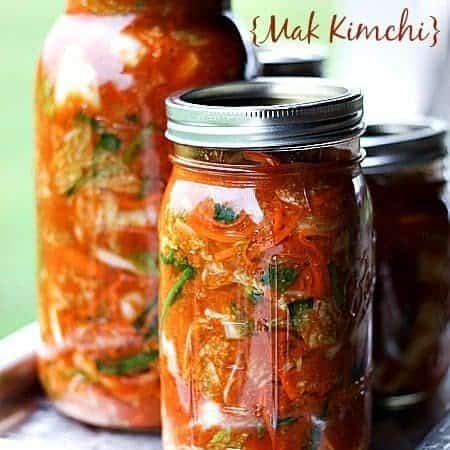
Easy, Fast Kimchi Recipe {Mak Kimchi}
Rate RecipeIngredients
- 3-8 pounds napa cabbage
- 2 bunches green onions trimmed of the root bits
- 2-3 large carrots peeled, thinly julienned
- 1/2 cup kosher salt
- 1/2 cup korean chili powder
- 15-20 cloves garlic overdoing garlic makes this stay on your breath more than usual., peeled
- 4-6 inches ginger peeled, rough chopped
- 1 tablespoon fish sauce
- unsweetened pear juice or unsweetened apple juice
- 4 tablespoons white miso paste
Instructions
- Cut the napa cabbage in half longways, then in half again longways. Cut the core out of the four quarters. Cut the cabbage into squares (about 2-3 inches square), pop it in a bowl with the carrots. Sprinkle with the 1/2 cup kosher salt, massage so everything is coated in salt and starting to soften and wilt. Fill with cold, chlorine free water to cover it well and let it soak for at least 1 1/2 hours.
- Pour the cabbage and carrots and liquid into a strainer. Let the brine drain away.
- Lob off the white bits of the green onions and put them in a food processor with the garlic cloves, ginger, miso paste, and korean pepper powder. Zap it on high ’til it’s smooth-ish. Add in the fish sauce and a couple of slops of pear juice and zap it more until it’s about pancake batter consistency… maybe a bit thinner.
- Put the brined cabbabe/carrots in a big, anti-reactive (glass, enamel, or stainless steel) bowl. Rough chop the green parts of the onions and add those to the cabbage/carrots. Pour the chili paste combo over the cabbage and wear gloves to massage it all over the cabbage/carrots green onions so everything is completely covered.
- Pack super tight in canning jars. CRAM it in there. Add a two-piece lid, but just set the ring in place to hold the lid down without screwing it in place. Place it on a rimmed baking dish to catch any spill-over. Let it sit at room temperature for up to 72 hours, until it is bubbly and fragrant. Once every day, insert a clean chopstick or butterknife to release air bubbles. If needed, pour in some additional brine to keep all the vegetables submerged.
- Store on a rimmed sheet in the refrigerator for up to six months, being sure that the vegetables are submerged the whole time. The older it gets, the stronger it will become.
Notes
Nutrition
Nutritional information is an estimate and provided to you as a courtesy. You should calculate the nutritional information with the actual ingredients used in your recipe using your preferred nutrition calculator.
did you make this recipe?
Make sure to tag @foodiewithfam on Instagram and #hashtag it #foodiewithfamily so I can check it out!
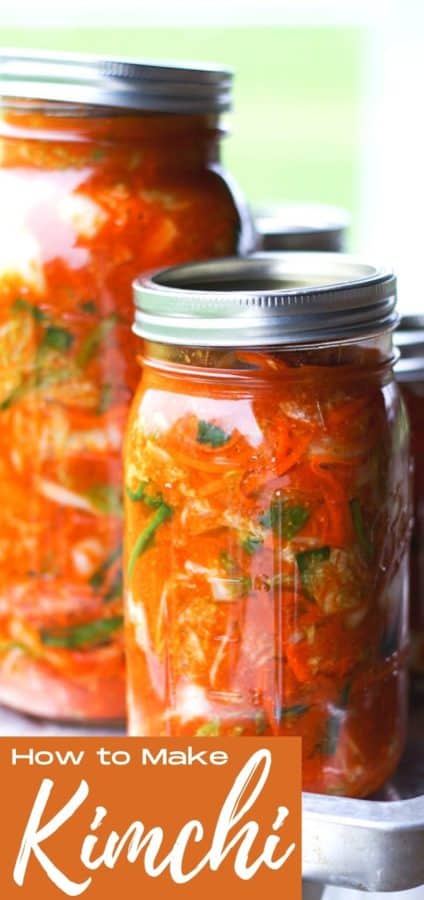
This post was originally published on December 2, 2013 and was updated December 28, 2016, June 2018, and September 2021.
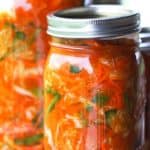



Reader's Thoughts...
priyanka says
HI,
what can i used instead of fish sauce as am vegetarian .
Rebecca says
Hi Priyanka- I’d go for a substitute of equal parts of soy sauce and rice vinegar. They do sell vegetarian “fish sauce”, though, if you’d like to get really close to the flavours!
Christine Lewis says
Hi ,
Thanks for your recipe. The first time I made it it was perfect but the second time a couple of months later it never fermented .Where did l go wrong ?
Rebecca says
Hi Christine- How? Wow. That’s a tough one to answer since I’m not in the kitchen with you. Did you do anything differently that you can think of?
TD says
Hi just making your recipe. Two questions: 1) how much pear juice? 2) is miso needed?
I apologize if you answered either but did not see either question. Thanks TD
Rebecca says
Hi TD- In the recipe card, it specifies using 4 tablespoons of miso paste. 🙂 As for the pear juice, you’re really just using it to loosen up the contents of the food processor when you make the paste. Glug in a tablespoon at a time as you process until it is a looser paste. 🙂
Mary E. says
You state: “If needed, pour some additional brine to keep the vegetables submerged….” However, the recipe never mentions to pour brine over the vegetables once they are in the canning jars. Is something missing here??
I crammed the veggies in the jar yesterday, and am letting them set, as you stated. They are not “submerged” in any brine right now.
Rebecca says
Hi Mary- I’m not sure what the issue is… if your vegetables aren’t submerged in their own juices, and don’t produce their own juices, you “pour some additional brine to keep the vegetables submerged…”
Megan says
Is it ok to soak the cabbage in the brine overnight?
Rebecca says
Hi Megan- I’m afraid I’ve never brined it longer than 3 or 4 hours, so I’m not sure what to say in answer to your question. 🙂
Encar F. Abinal says
Thank for the info and idea on how to make a kimchi. I will try when I am no longer busy.
Thank you.
Lauren says
I used this recipe for my first-ever kimchi experiment and WOW it was so so so good! I omitted the carrots and used anchovy sauce instead of the fish sauce but it was still phenomenal!
Rebecca says
Thank you so much for taking the time to rate the recipe and let me know you loved it, Lauren!
Laura says
Does the kimchi need to be in brine? The recipes said to drain it off, then said it needs to be covered in brine. Or will the fermentation process create needed liquid?
Rebecca says
Hi Laura- I usually top my jars off with a brine made of 4 teaspoons kosher salt dissolved in 1 quart water. 🙂
Deborah says
I can’t wait to try this recipe!
Rebecca says
I hope you love it, Deborah!
Jo says
Hello! Do you add the brining liquid to the jars or once you’ve strained it you no longer use that?
Rebecca says
Hi there! You no longer use that brining liquid. 🙂 You’ll want to whip up a fresh brine with 4 teaspoons kosher salt to a quart of water, shaken ’til salt is dissolved. 🙂
Sandy says
Hello Rebecca!
I am going to try making Kimchi for the first time ever. I have googled and read through countless recipes and keep coming back to yours, so that is what I am going to use.
I have several questions for you.
1. I just harvested a dozen large beautiful green cabbage from my garden, can I use that instead of Napa?
2. Can I use Vidalia or red onion instead of green?
3. Can I use red miso instead of white or would that be too strong tasting?
4. I have no apple or pear juice, just pineapple juice, I am thinking that probably would NOT work? Can I blend up an apple instead?
With the Covid-19 going on, I am avoiding going to town so this is what I have to work with.
I just ordered the Korean chili flakes that you recommended. It will be here on Friday.
I can’t wait to try this!!
Thanks!!
Sandy
Rebecca says
H Sandy- Let’s see if I can help you out with your questions.
1. You can use it, but it won’t be a “traditional” kimchi texture or taste. Green cabbage is much sturdier than napa and ferments differently. It’ll be delicious, but different. 🙂
2. The same answer applies to the onion situation as the cabbage one. Vidalias and Red Onions tend to have much more pronounced onion flavour, so I’d go easy on them if subbing them in.
3. I have not personally used red miso in place of white. I think I’d reduce it a smidge if trying it.
4. I would definitely blend an apple and not use pineapple juice. 🙂
I look forward to seeing how you like the end result with the substitutes!
Sandy says
Thanks for your reply 🙂 Our garden is on steroids this year so I have been swimming in tomatoes, beans, cukes, beets, squash etc…. and haven’t had a chance to make this. I’m setting all those veggies and canning to the side for today and going to finally make my first batch of kimchi. I will let you know how it turns out. Oh, I have another question! I have chopped leeks that I froze from the garden last year. Would those work better than the Vidalia or red onions? Thanks!
Sandy
Rebecca says
Hi Sandy- I think leeks would be good, but I’m not sure how frozen leeks would behave! I think you’re going to have some fun playing around and finding what combination you love best. What a nice problem to have!! 🙂
Sandy says
One more follow up question! I have the cabbage and carrots soaking in the brine. Can I add sliced green bell peppers to this?
Thanks!
Rebecca says
I think I’d take a pass on the bell peppers, personally, as I’m not sure how the flavour would work in there, but if you decide to give it a try, please let me know how it works out for you!
Sandy says
Thanks again for the quick response! I am going to forget the green peppers this first time, maybe throw them in next time, that way I can compare with and without . I am going to use the leeks as I’m thinking if it is going in the blender it shouldn’t matter if they are kind of mushy. I just ate a piece and it taste fine. So we shall see! 😉
Robert Hall says
Just made a batch today. Thank you for sharing your recipe.
Rebecca says
Thanks for taking the time to rate the recipe and let me know you like it, Robert! I appreciate it!
Suzanne says
Hi REbecca,
Thanks for this great recipe! I’ve made it three times and loved it each time. This time, it was really bubbling along on day 1 & 2 like usual, but then it just stopped. So I put it in the fridge, but do you think it is ok? It seems it just ran out of steam!
Rebecca says
I think that’s fine, Suzanne! Was your room temperature pretty warm? If so, it may have gone the distance faster. 🙂
SUzanne says
I bet that was it! It’s pretty warm this week here. I tasted it this morning and it’s delicious as always, so thanks!!
Rebecca says
Wonderful, Suzanne! I’m so glad it all worked out!
Kathy says
This is the 3rd time I have made this. So very easy to follow and tastes great!!!😊❤️
Rebecca says
Thank you, Kathy! I am so glad you love it and appreciate you letting me know!
Andee says
Hi! I just want to ask this. What if I can’t find u sweetened pear/apple juice? Is there an alternative for them? thanks!
Rebecca says
Hi Andee- You could simply grate an apple or pear into a bowl and either include the pulp or squeeze the juice and use the juice only. 🙂
Constance says
I just made it for the first time but I forgot carrots because not all recipes call for carrots so I have enough room in the jars to add carrots so how many days do I marinated at room temperature with a loosely screwed on top for the jar?
Rebecca says
Hi Constance- I’d skip the carrots this time vs. adding in without brining/not at the same time!
Lena says
Can i use green (cannonball) cabbage instead?
Rebecca says
Hi Lena- You can, but it will be different texturally!
Richard McAllister says
Can this recipe be frozen?
Rebecca says
Hi Richard- I wouldn’t freeze it. It ages and continues to get stronger (and in my opinion better) as it is stored in the refrigerator.
Eileen Boey says
Hi, for a 3pound cabbage how much liter container would you need for the finished product?
Rebecca says
Hi Eileen- I’m not certain. I usually just keep a handful of quart jars ready to go and stuff it in tight. 🙂 Whatever I don’t need, I just pop back on the shelf…
Steph says
Hi! I’m I’ve got my cabbage slathered in paste Ina jar but there’s a little air between lid and kimchi. I put a cabbage leaf on top and it’s pressed down, but do I need to cover that with brine? When you mention adding extra brine where does the brine come from? How do I create that?
Thank you! I’m so excited to eat this.
Rebecca says
Hi Steph- Yes, please! Pour some brine over it. Just shake together 4 teaspoons of kosher salt and a quart of water and keep that in the fridge to top off your kimchi as needed. 🙂